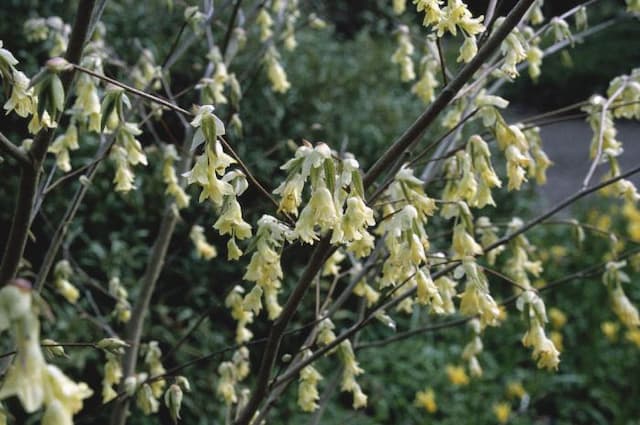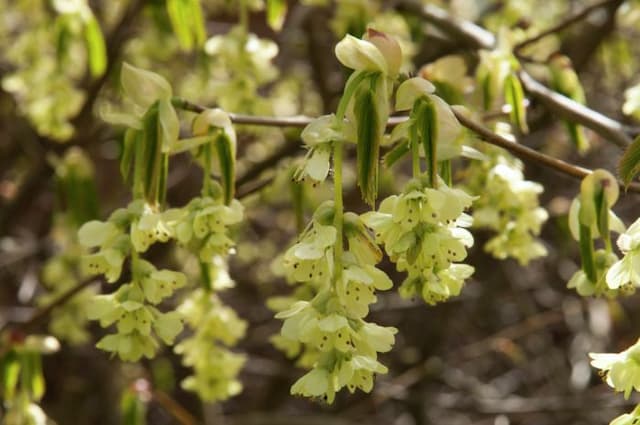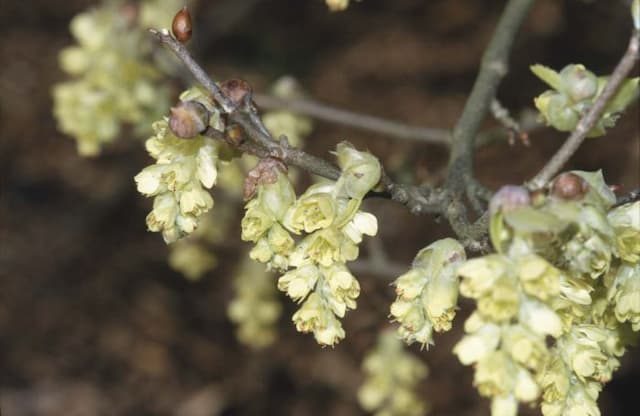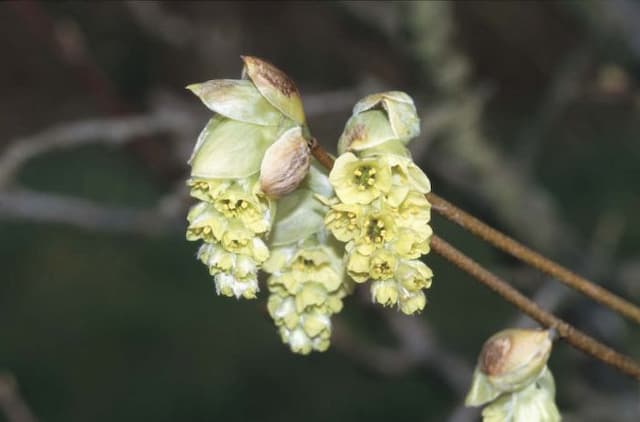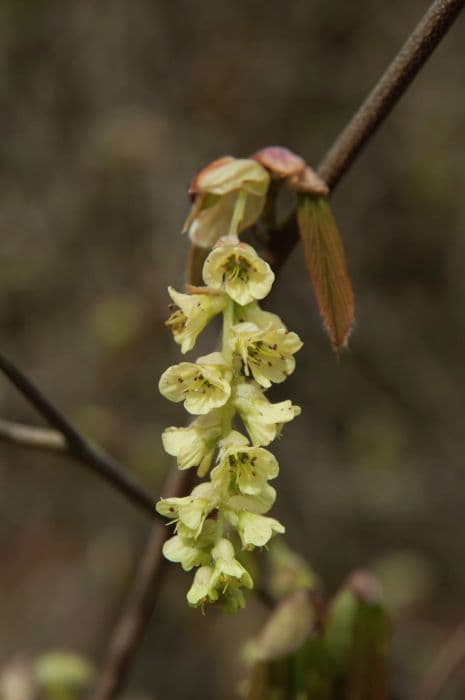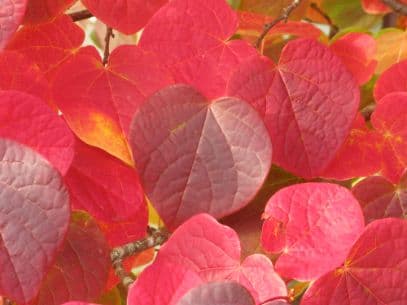Buttercup winter hazel Corylopsis pauciflora

ABOUT
Commonly known as the buttercup witch hazel, this plant is a deciduous shrub that boasts an impressive display both in early spring and again in the fall. As the chill of winter begins to wane, the buttercup witch hazel greets the new season with clusters of delicate, yellow flowers that dangle from its branches like tiny chandeliers. Each flower consists of four narrow, crinkled petals that exude a soft, pleasing fragrance, attracting early pollinators. The leaves of the buttercup witch hazel are equally distinctive. When they unfurl, the leaves are a light, fresh green and have a softly downy texture. As the season progresses, they deepen into a darker shade of green, providing a lush backdrop for the brighter colors of spring and summer blooms within a garden. In the fall, these leaves stage a final act of brilliance, transforming into golden yellow shades that rival the flowers' early spring show. The bark of the buttercup witch hazel is smooth, providing a subtle texture year-round. This bark is a modest backdrop for the plant's more showy features and adds to the overall aesthetic of the plant throughout the seasons. Overall, the buttercup witch hazel is a symphony of seasonal colors and scents, with a form that is both elegant and slightly whimsical, making it a cherished addition to any garden looking for year-round interest and beauty.
About this plant
 Names
NamesFamily
Hamamelidaceae
Synonyms
Buttercup Witch Hazel, Winter Hazel
Common names
Corylopsis pauciflora.
 Toxicity
ToxicityTo humans
The plant known as Buttercup Winter Hazel (Corylopsis pauciflora) is not commonly listed as a toxic plant to humans. There is limited information available on severe toxicity or poisoning from ingesting this plant. However, it is generally a good practice to avoid eating ornamental plants as they are not intended for consumption and their effects on humans can be unpredictable. If any part of the plant were to cause a reaction, it might result in stomach upset or an allergic reaction in some individuals.
To pets
The Buttercup Winter Hazel (Corylopsis pauciflora) does not have a widespread reputation for being toxic to pets. However, since many plants can cause gastrointestinal upset or other mild symptoms when ingested by pets, it is advisable to prevent pets from consuming this plant. There are no well-documented cases of poisoning in pets from this plant, but as a precaution, should a pet ingest Buttercup Winter Hazel and exhibit unusual symptoms, contact a veterinarian.
 Characteristics
CharacteristicsLife cycle
Perennials
Foliage type
Deciduous
Color of leaves
Green
Flower color
Yellow
Height
4-6 feet (1.2-1.8 meters)
Spread
4-6 feet (1.2-1.8 meters)
Plant type
Shrub
Hardiness zones
5
Native area
China
Benefits
 General Benefits
General Benefits- Aesthetic Value: Corylopsis pauciflora, commonly known as buttercup winter hazel, adds ornamental appeal to gardens with its delicate yellow flowers and attractive foliage.
- Seasonal Interest: It blooms in early spring, providing early seasonal interest after the winter months.
- Wildlife Attraction: The flowers can attract pollinators such as bees, adding to the biodiversity of the garden.
- Shade Tolerance: Buttercup winter hazel can tolerate partial shade, making it versatile for different garden locations.
- Low Maintenance: Once established, it is relatively low maintenance, requiring minimal care beyond occasional pruning.
- Compact Growth: With its small to medium size, it fits well in smaller gardens without overwhelming the space.
 Medical Properties
Medical PropertiesThis plant is not used for medical purposes.
 Air-purifying Qualities
Air-purifying QualitiesThis plant is not specifically known for air purifying qualities.
 Other Uses
Other Uses- Butterfly Attraction: Corylopsis pauciflora, commonly known as winter hazel, can be used in gardens to attract butterflies as they are drawn to the flowers for nectar in early spring.
- Woodworking: The wood of winter hazel is often used for creating small decorative items due to its fine grain and workable nature.
- Photographic Subject: The delicate blossoms of winter hazel make it a popular subject for botanical photography, particularly in spring.
- Thematic Gardens: Winter hazel can serve as a thematic centerpiece in winter-themed gardens due to its early flowering habit.
- Perfumery: The fragrance of winter hazel flowers can inspire scents for perfumes and scented candles.
- Floral Arrangements: The branches of winter hazel, when in bloom, can make stunning additions to floral arrangements and bouquets.
- Education: Winter hazel can be used in educational settings as an example of early-blooming plants, allowing students to study its biology and flowering process.
- Festivals: In some cultures, the blooming of winter hazel is celebrated as a sign of spring, and its branches may be used in festival decorations.
- Landscape Painting: Artists may use winter hazel as inspiration or as actual subjects in landscape paintings due to their aesthetic appeal and indication of seasonal change.
- Literary Inspiration: Poets and writers sometimes reference winter hazel in their works to evoke the sense of renewal that comes with the end of winter and the onset of spring.
Interesting Facts
 Feng Shui
Feng ShuiThe Winter Hazel is not used in Feng Shui practice.
 Zodiac Sign Compitability
Zodiac Sign CompitabilityThe Winter Hazel is not used in astrology practice.
 Plant Symbolism
Plant Symbolism- Spring Renewal: Corylopsis pauciflora, commonly known as Buttercup Winter Hazel, is one of the early bloomers in spring, symbolizing new beginnings and the rejuvenation of life.
- Delicate Beauty: With its small, delicate yellow flowers, the Buttercup Winter Hazel represents the understated elegance and beauty that can be found in the smaller details of nature.
- Simplicity: The simple and unassuming appearance of the Buttercup Winter Hazel can symbolize the value of modesty and the beauty in simplicity.
- Optimism: The bright yellow blooms of this plant are often associated with warmth and sunshine, signifying optimism and the positive side of life.
- Rarity: As the Buttercup Winter Hazel is not as commonly found as other garden plants, its presence can also symbolize uniqueness and rarity.
 Water
WaterWinter Hazel should be watered deeply but infrequently to mimic natural rainfall patterns. Generally, watering about 1 inch of water per week, including precipitation, is sufficient during the growing season. During the summer, if there is no rain, increase watering to about 1.5 inches every week. During the winter months, reduce watering significantly, providing only enough to prevent the soil from completely drying out, which might be equivalent to about half a gallon for potted specimens or less, depending on the size and environment. Always check the top inch of soil for dryness before watering again.
 Light
LightWinter Hazel performs best in bright, indirect light. It is ideal to place the plant in an area where it will receive morning sunshine and afternoon shade. Avoiding direct, harsh sunlight, especially in the afternoon, is crucial to prevent leaf scorch. A dappled sunlight under taller trees or an east-facing garden spot usually offers the optimal conditions for this plant.
 Temperature
TemperatureWinter Hazel prefers moderate temperatures and thrives in a range between 60 and 75 degrees Fahrenheit. It can tolerate minimum temperatures down to around 20 degrees Fahrenheit but should be sheltered from frost to prevent damage. Ideal growing conditions will avoid the extremes, as prolonged exposure to temperatures above 80 degrees Fahrenheit or below freezing can be detrimental.
 Pruning
PruningWinter Hazel should be pruned after flowering to maintain its shape and encourage healthy growth. The best time for pruning is late spring or early summer, following the bloom cycle. Thinning out old branches and removing spent flowers can promote better air circulation and new blooms for the following season. Regular light pruning can be done annually, while more significant shaping should be done every few years.
 Cleaning
CleaningAs needed
 Soil
SoilWinter Hazel thrives in moist, well-drained soil, with an ideal pH range of 5.5 to 7.0. A mix of loamy soil with peat and pine bark would provide good structure and acidity. Adding perlite or coarse sand can improve drainage, essential for healthy root growth.
 Repotting
RepottingWinter Hazel should be repotted every two to three years to ensure it has enough room for root growth and to refresh its soil. Early spring, before new growth starts, is typically the best time for repotting.
 Humidity & Misting
Humidity & MistingWinter Hazel prefers moderate to high humidity levels. A range between 40-60% is adequate for this plant's health, simulating its native woodland habitat.
 Suitable locations
Suitable locationsIndoor
Provide bright, indirect light, and moderate humidity.
Outdoor
Plant in dappled shade with moist, well-drained soil.
Hardiness zone
5-8 USDA
 Life cycle
Life cycleCorylopsis pauciflora, commonly known as buttercup winter hazel, starts its life cycle from a seed, which upon germination produces a small root system and a shoot that emerges from the soil. As a juvenile plant, it develops a framework of branches and leaves in a shrub form, displaying characteristic pale yellow, fragrant flowers in early spring before the leaves fully expand. After pollination, typically by insects, the fertilized flowers develop into small, woody capsules that release seeds when mature. Over the years, the buttercup winter hazel experiences periods of vegetative growth and flowering, with this seasonal cycle repeating annually. As the shrub matures, it can reach up to 1.5 meters in height and spread, forming a rounded shape. Eventually, as the plant ages, growth slows, and it may become less vigorous, ultimately concluding its lifecycle upon death from environmental factors or old age.
 Propogation
PropogationPropogation time
Early spring
Propogation: The most common method of propagating Corylopsis pauciflora, also known as Buttercup Winter Hazel, is through semi-hardwood cuttings. This technique is best performed in late summer, after the current season’s growth has begun to mature but is not fully hardened. Cuttings should be about 4 to 6 inches (10-15 cm) long and include several leaf nodes. The lower leaves are removed and the base of the cutting is treated with a rooting hormone to encourage root development. The cutting is then planted in a well-draining potting mix, with the lower nodes buried where roots will form. Consistent moisture and a warm environment are critical until the cuttings have rooted, which can be checked after a few weeks by gently tugging on the cuttings to feel for resistance, indicating root growth.
